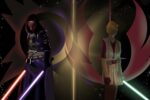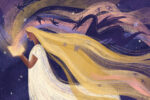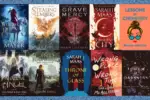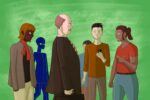Began when Christopher Paolini graduated from homeschool at 15 years old, “Eragon” is a seminal work of fantasy that originated as a self-published novel. Years later, it has legions of dedicated fans, a compendium of fan-made art, a film adaptation and tons of merchandise befitting the worldwide phenomenon the series has become. Paolini created an unforgettable cast of characters, a world almost as tangible as Earth itself and a virtually flawless magic system combined with extensive lore and history to make the series an indelible memory for all who read it. Even now, new audiences discover and fall in love with the world of Alagaësia every day, proving its strength of character and the genius of his writing.
Plot and Worldbuilding
One of the strongest elements of “The Inheritance Cycle” is the unfolding of the classic fantasy plot. Paolini reportedly “plotted out the entire trilogy before [he] even wrote it” (there ended up being four books) and it’s evident in the almost-perfect pacing of each novel.
Each installment has just the right proportion of action, emotion, and exposition. Most of the info-dumping is taken care of in the first book, where the reader learns about the world of magic and dragons alongside Eragon, the titular character. From then on, in terms of lore and world-building, the series is more of an accelerated class based on prior, foundational knowledge than a slow, introductory lecture.
Beginning in Eragon’s native rural home, Palancar Valley, Paolini reveals several historical myths to give the place a sense of character. Eragon’s discovery of a dragon egg, the presence of magic and his new dragon, Saphira, all allow the reader to see the valley through the new eyes of both dragon and Dragon Rider.
The inspiration for Alagaësia, the fictional land where the series takes place, comes from Paolini’s own home landscape in Montana. He echoes the nearby Beartooth Mountains in his descriptions of his own fictional Beor Mountains, a massive range of crags and peaks that takes up the south-eastern border of the continent. Understanding how much wider the world is outside his valley, Eragon sets out to explore. Paolini does a wonderful job mapping out the transitions from location to location, intricately following Eragon’s travels through mountain, desert, wood and sky. By the time Eragon meets his first elf, both reader and main character already have a sense of belonging in the world of Alagaësia, a transition that isn’t always executed smoothly in fantasy but which Paolini achieves through an in-book storyteller that provides exposition to the reader through Eragon.
A succession of landmarks serves to flesh out the rest of the map, including cities like Uru’baen, Dras-Leona and Gil’ead, as well as locations like the Hadarac Desert and Du Weldenvarden (the impenetrable forest home of the elves). Because of Paolini’s dedication to constructing a visceral world through his descriptions, readers truly feel like they are traversing the map and exploring the world as Eragon does — weather changes, the shadows of the Beor Mountains, the spray of water at a secret cave entrance — creating an immersive experience.
Languages and Magic System
The flow of magic and energy within the series is controlled by the Ancient Language, an extensively researched and referenced dialect created by Paolini and largely based on Old Norse. However, as far as grammar and pronunciation go, he says “they bear absolutely no resemblance to Old Norse” as he wanted to “give it [his] own twist.” Adding depth to the world and various cultures, the languages (Dwarf, Nomad, Urgal, Ancient and English) are aided by numerous grammatical rules and dictionaries compiled by Paolini over the course of writing the series.
The Ancient Language, which is also the language that the elves use, is almost a character in itself, with specific approved wordings and usages alongside unique curses that add an element of comedy to the dialogue. Similar to “The Lord of the Rings” and “Game of Thrones,” the variety of languages makes the story more believable and offers another aspect for readers to latch on to throughout the series.
Though many main characters can use magic, Paolini emphasizes that “to work with magic, [one] must have a certain innate power.” While it can be refined through tutelage and practice, the privilege is mostly restricted to the elves, Dragon Riders, dragons and the occasional human, producing a sense of power and mystique whenever a magic-wielding character is encountered. By the second book, “Eldest,” it becomes clear to both Eragon and the reader that a foe with a developed grasp of the Ancient Language is to be feared. In fact, a wording mistake made by Eragon results in a child being cursed to feel others’ pain, a plot point that carries through to the end of the series.
Evoking such reactions in readers at the mere mention of a character’s abilities, especially powers that go beyond simple brute strength or fighting ability, is another reason the books are a seminal work. As in the “Harry Potter” books, the complexities of the magic system that must be mastered via study give the concept more weight. Instead of ability alone, intellect plays a factor in a character’s formidability, twisting the trope of overpowered characters and making the magic that is used seem more realistic rather than the “have or have not” situation that many books use.
Characters and Cultures
Another of the series’s pillars is the characters Paolini brings to life. Spanning many races and species (Elf, Dwarf, Shade, Urgal, Werecat, Dragon, etc.), the creatures that inhabit Alagaësia are just as, if not more important than the humanoid ones. They even have special attributes. that make them otherworldly. Upon her introduction in the early pages of book one, Saphira (Eragon’s dragon) quickly becomes an anchor point of the story. Paolini wrote her with a more human attitude since she grew up under Eragon’s care and in a very human environment. Once under the guidance of another dragon, though, she learns the tricks of the trade, as well as flying techniques, passed down from dragon to dragon that Eragon and other humans cannot teach her, and these all serve to develop the character and world more fully.
The Dwarves are known for their works of metal and stone, which come from living underground and a culture built around craftsmanship. Within each society are also intricate politics that Paolini lays out piece by piece for Eragon to experience — in “Eldest,” the Dwarves introduce their halls and King Hrothgar, as well as their traditions and religions. They live in clans, and after Eragon offends a member of a mourning clan, they declare him a blood enemy, a situation that takes delicate negotiation (and perhaps a knife to the throat) to rectify.
In Du Weldenvarden, the land of the elves, the inhabitants are traditionally long living and wise in the ways of magic, able to alter their appearances by invoking the Ancient Language. The elves exhibit all the typical characteristics of any immortal race, such as high intelligence, a proficiency for magic rivaled only by the dragons themselves, superhuman strength, endurance, speed and agility, as well as being the “fairest people of the land,” all representative idiosyncrasies that any fantasy reader is familiar with.
Much of the kinks of the Ancient Language and magic system are ironed out during Eragon’s training years, including its rules, effects on spellcasters and the source of its energy, as well as lore regarding historic magic users and past Dragon Riders. Paolini mimics real life by giving similar yet slightly altered histories through the eyes of each race (there is a particularly heated argument between an elf and a dwarf regarding religion and gods). Different cultures have diverging ideas of the beginning of the world and offer readers the option of what to believe.
Clichés
Despite being an indisputably original and fantastic work of fiction, “Eragon” and the rest of “The Inheritance Cycle” fall victim to many fantasy clichés, though Paolini manages to iron them out with his own twists. Brom, the mysterious village storyteller, is essentially a Gandalf-esque character (and shocker: Eragon’s father) that leads Eragon to the start of his four-book journey. He gives him just enough of the necessary tools to succeed, including a timely sacrifice that gives Eragon the push he needs to continue his travels. Du Weldenvarden mimics Tolkien’s Lothlórien in its secluded, elf-inhabited airs. Even the magic system shares aspects of other creations (namely the Force in “Star Wars“) in that it can be felt swirling through all living things.
Arya, the elf Eragon rescues in the first book, turns out to be the woman he spends the next three books pining after. True to cliché, she spends the next three books discouraging him — but in Paolini’s genius writing, it’s at least for better reasons than playing hard to get. She also turns out to be the elven queen’s daughter, which is both a plot twist and not at all shocking considering her attitude toward humans as well as the fellow elves’ reactions to her. The plot does deviate from the norm when she doesn’t end up with Eragon at the close of the final book, “Inheritance,” though Paolini certainly writes it in such a way that it’s open to interpretation whether the next several decades (or centuries) of their lives will be intertwined.
Another cliché is the big, bad villain, Galbatorix, being defeated by, essentially, the power of friendship and love. However, after fighting numerous and unending tides of enemies, there weren’t many other ways to end the final confrontation — beheading, stabbing through the heart, magic attacks and burning creatures to death had already been used — and to his credit, Paolini writes the scene in a way that it does indeed feel like the climax of all four books.
In the end, “The Inheritance Cycle” stands atop a fantasy-book-strewn peak. The deeper issues addressed through the characters’ trials and tribulations, asking for the meaning of life, how to live honorably and how to face and overcome even the most extraordinary of challenges give the series a weight that others lack. At the same time, there are plenty of plot twists, action sequences and intense relationships to excite readers as they learn more about Alagaësia.
Like most great works of fantasy, the reader and the main characters discover the world simultaneously; when Eragon is bewildered or amazed by the worlds he steps into, the audience is as well. Detailed lore and history, along with several homemade languages and original takes on traditional fantasy concepts make “Eragon,” “Eldest,” “Brisingr” and “Inheritance” all separate masterpieces that, combined into one epic narrative, will remain popular for many years to come.

















